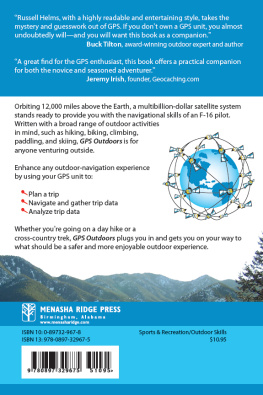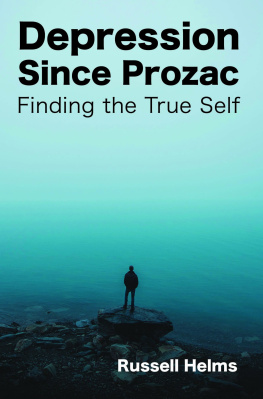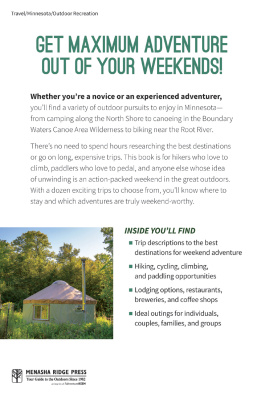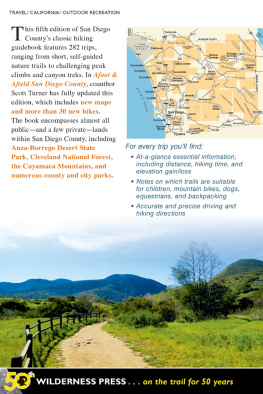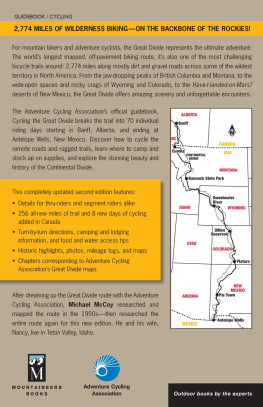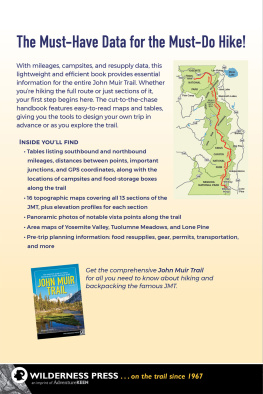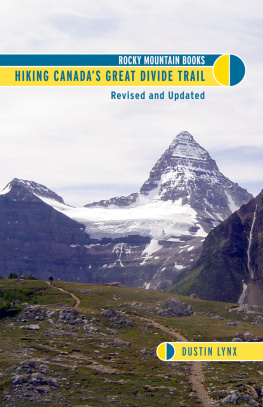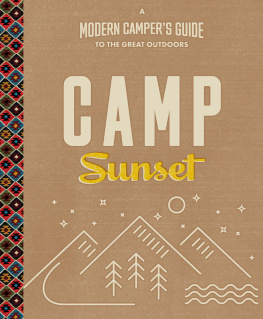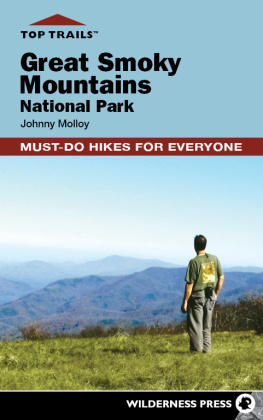

Copyright 2006 Russell Helms
All rights reserved
Printed in the United States of America
Published by Menasha Ridge Press
Distributed by Publishers Group West
First edition, first printing
Library of Congress Cataloging-in-Publication Data
Helms, Russell, 1963
GPS outdoors: a practical guide for outdoor enthusiasts/Russell Helms.1st ed.
p. cm.
ISBN 10: 0-89732-967-8
ISBN 13: 978-0-89732-967-5
1. Outdoor recreationEquipment and supplies. 2. OrienteeringEquipment and supplies. 3. Global Positioning System. I. Title. II. Title: Global Positioning System Outdoors.
GV191.623.H44 2006
796.50284dc22
Cover design by Travis Bryant
Text design by Annie Long
DEDICATION
For my grandfather Orris Jennings Helms.
He was never lost
ACKNOWLEDGMENTS
MANY THANKS to friends and family who have endured a spontaneous GPS lecture or who may have accompanied me on one of my many outdoor GPS adventures. In the line of hardware, I would like to thank Suunto for their generous donation of the X9i. Steve Lovell of Garmin deserves kudos for his overall assistance in enabling Menasha Ridge Press to spread the word about GPS and units such as the Garmin Etrex models. In the realm of software, DeLorme has been generous, supplying copies of their TopoUSA program.
Heartfelt thanks also go out to the many guidebook authors I have coached in the use of GPS technology. Their success is my success.
Finally, I would like to say thank you to the fine folks at Menasha Ridge Press and a very special thanks to my wife, Linda, and daughters, Lucy and Cora. GPS may keep me on the trail, but they are the ones who bring me back home.
Russell Helms
PREFACE
GPS UNITS, combined with , enhance any outdoor outing by assisting you with:
Whether youre a climber, road biker, hiker, fly fisherman, trekker, or even a hot-air ballooner, GPS can make your next outing more interesting, less risky, and perhaps even more enjoyable. As you will read, GPS technology is at once fascinating, easily accessible, inexpensive, reliable, and useful. There are weaknesses, though, as with any technology, and those are covered as well.
After reading this book and familiarizing yourself with your own personal GPS unit, youll be ready to hit the trail, plug into the satellites overhead, and experience a new level of navigation.
INTRODUCTION
NO ONE is more surprised than I am to be a fan of GPS technology. Getting outside (and usually getting dirty) is simply sacred, whether Im scrambling up rock faces, trudging up steep trails, or barreling down single-track. Time spent outdoors is precious, and woe is the barrier that comes between my explorations and me. GPS units are extremely useful gadgets but need to be understood. Just as you dont want to set up a new tent in the dark, you dont want to have to figure out what GoTo means after youve wandered off trail and become hopelessly lost. In inexperienced hands, a GPS unit can make a simple outing an unhappy one.
To read any outdoor magazine is to immerse yourself in a culture of gadgets, gear, and gewgaws. Admittedly, there are extreme situations in which your life may hang on a bit of technology. But for the majority of outdoor enthusiasts and participants, less is always better. To me, Polartec clothing is the best thing since sliced bread. I have a medium-weight Polartec jacket that sees me through 95 percent of outdoor pursuits in chilly weather. But Ive fared just as well with much cheaper acrylic sweaters from the thrift store!
Whats my favorite outdoor activity? Although I enjoy riding my mountain bike to work, what really turns me on is diving into a patch of thick woods and getting completely lost. If its an area Im familiar with, all I need is a water bottle, an energy bar, and a hat in case Im out after dark. So why would I buy a GPS unit?

Because theyre small, theyre relatively inexpensive, and they provide the biggest tax-dollar bang-for-the-buck that I can imagine. When I switch on the GPS, Im plugging into a multibillion-dollar satellite-based navigation system that is coddled in some manner by several of the largest and most powerful U.S. government agencies, including all branches of the military beneath the wings of the Department of Defense and the Department of Transportation. Its almost irresistible once you realize the enormity of what a simple $150 cell phonesize device can do.

This guide is designed to explain quickly and easily the wondrous possibilities and practical uses of a handheld GPS receiver. A GPS unit, coupled with inexpensive topographic-map software, allows you to preview your excursion, gets you to the jumping-off point, guides you along the way, and provides you with a visual record of your adventure much as a camera does.
On hikes that Ive done dozens of times, I routinely take my trusty Garmin Etrex along, especially if Im with other people.
How far have we gone? inquires hefty Aunt Sarah after a short uphill spurt.
With a twinkle in my eye, I reply, Exactly 0.35 miles instead of Im not sure or Probably about a half mile.
I could also rattle off a dozen other interesting details such as, Our average moving speed is 5.3 miles per hour or Weve ascended 38 vertical feet or At this pace, it will take us exactly three weeks to return to the parking lot.
On a solo day hike along the brushy West Fork Sipsey in north-central Alabama, I encountered a married couple and their teenage daughter walking in the opposite direction. They were on the trail and within easy reach of the parking area, but the looks on their faces signaled distress. It was pretty hot that day, and they had already beat out 10 miles or so. They were tired, and evidently the wife and daughter had begun to doubt their whereabouts. Was Dad leading them astray?
Glancing at my GPS unit, the man asked me how far it was to the parking area. I replied, 1.4 miles.
How far, how far? asked his wife eagerly.
1.4 miles, I repeated.
And this is the Sipsey River Trail, right?
Yes, I replied.
And the parking area by the bridge is 1.4 miles from here?
Yep.
Ive never seen such a forlorn group perk up as quickly they did, simply from a few bits of information. I may have even saved a marriage.
Can you head into the woods with a GPS device and expect to never get lost? No. The primary danger of a GPS unit is that it can and does fail. What if your batteries die? What if cloud cover and unfavorable satellite positions result in a prolonged period of signal loss? What if you drop the unit into a Class-V river? Well, youd better have a backup plan.
As fascinating and useful as GPS is, you must still be prepared and able to navigate without it. The primary backup is the map and compass. A concise overview of how to use them. Using GPS will greatly enhance your understanding of the , but its wise to hone basic navigational skills before or in conjunction with use of a GPS unit. An excellent text for anyone interested in learning more about map-and-compass navigation, or orienteering, is Be Expert with Map and Compass by Bjrn Kjellstrm.
Next page
